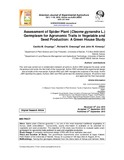Assessment of spider plant (cleome gynandra l.) germplasm for agronomic traits in vegetable and seed production: a green house study

View/
Date
2015-09Author
Onyango, Cecilia M.
Onwonga2, Richard N
Kimenju, John W.
Type
ArticleLanguage
enMetadata
Show full item recordAbstract
Aims: Spider plant (Cleome gynandra L.) is one of the most important traditional vegetables in Kenya, albeit underutilized. Concurrently, scanty information is available on its potential for vegetable and seed production. The objective of this study was therefore to evaluate spider plant germplasm for agronomic traits pertinent to seed and vegetable production.
Study Design: A complete randomized design (CRD) with three replicates was used.
Place and Duration of Study: Two greenhouse experiments were conducted at Upper Kabete Field Station of the University of Nairobi, Kenya, for a period of 180 days (March-August, 2014).
Methodology: Twenty-five genotypes obtained from the Gene bank of Kenya and farmers’ fields were grown in 10 kg pots filled with a mixture of soil and cow manure at ratio of 1:2. Three seeds of each genotype were planted per pot and evaluated for days to seedling emergence, germination percent, leaf formation, days to flowering, days to pod formation, number of pods per plant, number of seeds per pod and weight of 100-seeds.
Results: Seedling emergence, leaf formation, days to flowering, days to pod formation, number of pods per plant, number of seeds per pod and 100-seed weight varied significantly (P=.05) between genotypes. Nineteen out of 25 genotypes emerged within 5 to 7 days, time to flowering ranged between 30 days in GBK-045494, and 42 days in GBK-040449, GBK-032229 and GBK-032134. Eight genotypes produced between 11 and 13 leaves per plant within six weeks. All the genotypes had a low (<50%) germination percentage.
Conclusion: GBK-040449, GBK-027212, GBK-032210 and GBK-032340 with; 4-7 days to emergence, >11 leaves per plant and ≥35 days to flowering are desirable for vegetable production, whereas, GBK-040449, GBK-045494 and SN 1 with ≥40 Days to pod formation, 6-9 pods per plant; ≥100 seeds per pod and 0.14-0.16g per 100-seeds are recommended for seed production. GBK 040449 was found to have traits suitable for both vegetable and seed production.
Citation
Onyango, C. M., Onwonga, R. N., & Kimenju, J. W. (2016). Assessment of Spider Plant (Cleome gynandra L.) Germplasm for Agronomic Traits in Vegetable and Seed Production: A Green House Study. American Journal of Experimental Agriculture, 10(1).Publisher
University of Nairobi
